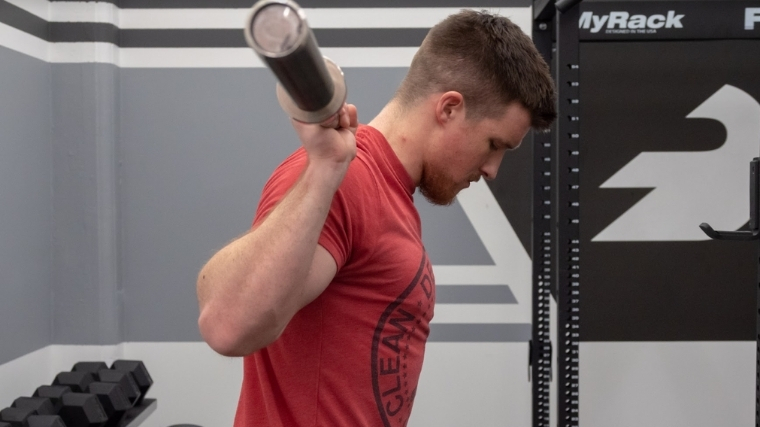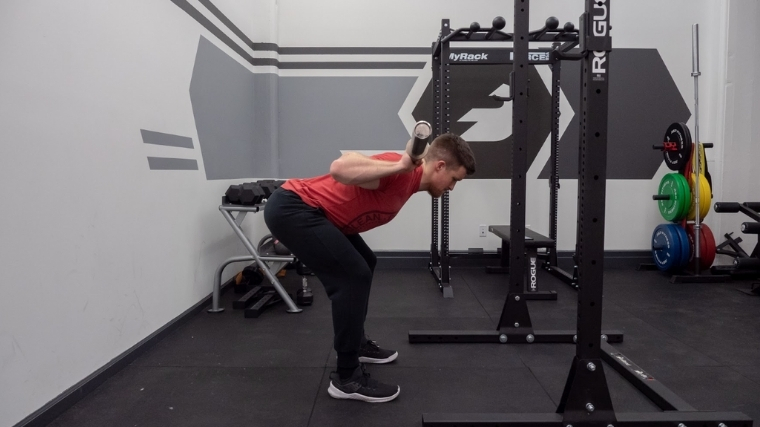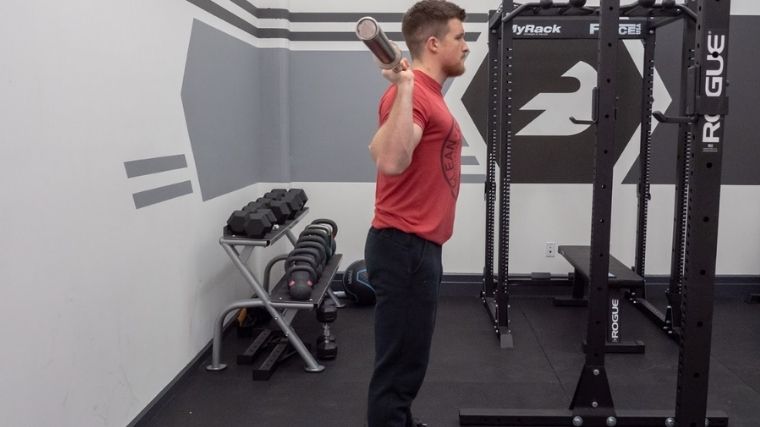The name tells you absolutely nothing about the exercise, but lifters laud the good morning for its ability to increase hamstring and glute strength, teach proper hip hinge mechanics, and help you to add pounds to compound movements like the back squat and deadlift. If you’re an athlete that plays a more dynamic sport (football, basketball, or soccer, for example), the good morning’s hip-strengthening properties will allow you to run faster and jump higher.
There is one downside to the good morning: a higher risk of back injury. Loading weight onto your back and then leaning forward is risky and, when done incorrectly or hurriedly, can put your spine at risk. But below is everything you need to know to perform good mornings correctly to ensure the gains without the pains.
- How to Do the Good Morning
- Good Morning Sets and Reps
- Common Good Morning Mistakes
- Good Morning Load Variations
- Good Morning Load Alternatives
- Muscles Worked by the Good Morning
- Benefits of the Good Morning
- Who Should Do the Good Morning
- Frequently Asked Questions
Editor’s note: The content on BarBend is meant to be informative in nature, but it shouldn’t take the place of advice and/or supervision from a medical professional. The opinions and articles on this site are not intended for use as diagnosis, prevention, and/or treatment of health problems. Speak with your physician if you have any concerns.
How to Do the Good Morning
The good morning can be done standing or sitting — both of which are solid variations — but the description below is for the more common standing variation.
Step 1 — Establish Your Stance and Back
Set a barbell in a squat rack to the height you normally squat from. Set your hands so the pinky is on either the first or second knurling ring (similar to your back squat setup). Position the barbell across your traps. Take a few steps back. Stand with your feet hip-width apart and turn your toes slightly outward. Bend your knees just a little bit.
Form Tip: Play around with your foot position, but a hip-width stance is generally a great starting point for most people.
Step 2 — Push Your Back Pockets Backward
Squeeze your shoulder blades together, brace your core, and and bring your elbows down and in so the bar fells tight against your body. Drive your butt straight back so your torso hinges forward toward the floor. Keep driving your butt backwards. Maintain a soft bend in your knees. Hinge until your chest is nearly parallel with the floor and your hamstrings feel engaged.
Form Tip: Ensure your shin angle is vertical, and do not allow your knees to bend too much.
Step 3 — Drive Your Back Pockets Forward
Maintain a rigid back. Slowly thrust your hips forward. Keep driving your hips until you’re standing again. Flex your glutes hard at the top. Repeat.
Form Tip: At the top of the good morning, keep your glutes and back contracted.
Good Morning Sets and Reps
You’re not going to load up the good morning to a one-rep max, but that doesn’t mean you can’t go heavy. Just make sure you’re not lifting heavy without proper preparation, as that can increase your injury risk.
If you’re concerned, rest assured — bodyweight good mornings are also extremely effective. Both ends of the spectrum can work wonders for your posterior chain training. It all depends on how you choose to integrate this move into your repertoire.
- For Warm-Ups: Do two to three 12 to 15 reps with your bodyweight, moving slowly and concentrating on activating your hamstrings and glutes.
- For Muscle-Building: Perform two to three sets of eight to 12 reps, leaving two to three reps in the tank each time.
- For Strength: Build up to being able to perform three to four sets of six to eight reps with fairly heavy weight.
To reduce the risk of injury, this isn’t necessarily a move you want to perform to failure. Plan your rep schemes and weights accordingly.
Common Good Morning Mistakes
The good morning has a lot of offer lifters in terms of building a strong and muscular posterior chain. But doing it wrong can be costly. Check out these common good morning mistakes to make sure none of them worm their way onto your lifting platform.
Using Too Much Weight
You can load up good mornings fairly heavily once you get the hang of the move, but that doesn’t mean you always should. If squats or deadlifts tend to cause you low back pain, good mornings are probably not the move for you.
When and if you do decide to lift heavier, make sure your form is on point first. Have your back maintain a neutral, locked position throughout each rep. You should be hinging at your hips to help keep the bar moving, rather than curving your back to wrestle the bar into position on the way down or on the way up. If you find yourself unable to hinge successfully or are overcompensating by compromising the shape of your back, reduce the weight significantly.
Collapsing Your Chest
Especially if you’re using too much weight, you might be prone to collapsing your chest or curling your back toward the bottom of your hinge. This may help you feel like you’re approaching parallel to the ground faster, but try focusing on quality instead of speed.
If you feel like you need to rush the reps to maintain good form — or compensate by curving your back and collapsing your chest — you’re probably using too much weight. Drop the weight and focus on maintaining a neutral spine. Do this by pushing your hips back to help move the weight while your torso remains in a steady, unchanging plank.
Not Focusing on the Hinge
If you’re focused on bending over with your upper back rather than pushing out and backward with your hips, you risk missing the entire point of the exercise. Focusing on your hip hinge will help maintain a safer bar path, not to mention engage your hamstrings. Concentrate on sending your hips back during this move to maximize its safety and effectiveness.
Good Morning Variations
Want to spice up your good mornings? Check out these variations that can help improve technique, strength, and performance.
Safety Bar Good Morning
Doing the good morning with a safety bar alleviates pressure on your shoulders from using a straight bar on your back. This is a great way also to force lifters to keep a flat back and brace their core more effectively.
The ability to secure the load safer on your back makes this a great go-to variation for all levels, especially if you struggle with shoulder mobility.
Seated Good Morning
The good morning can be done from a seated position to isolate your spinal erectors and minimize hamstring tension. This decreases the amount of weight someone can lift compared to the standing good morning.
However, it takes the hamstrings and glutes out of the movement and makes it a purely lower back (erector) exercise.
Good Morning Alternatives
Good mornings don’t feel so good on your back? Here are three good morning alternatives to help you shake things up.
Romanian Deadlift
The Romanian deadlift is an alternative that can build bigger, stronger hamstring and glutes. It also has broad application to many of the same movements the good morning affects, like the squat and deadlift.
This is a great alternative if lifters are looking for a more pulling-specific accessory exercise or someone who cannot properly load a barbell onto their backs.
Hyperextension
The hyperextension loads the same muscle groups as the good morning, but also helps to isolate your lower back muscles.
This is closely related to the seated good morning variation and may be a good option for lifters who fail to keep a flat back during good mornings, squats, and deadlifts.
Snatch-Grip Romanian Deadlift
The snatch grip Romanian deadlift can be used to reinforce lat strength and proper back position during the Romanian deadlift. Often, lifters will allow their backs to round out during Romanian deadlifts, which can lead to injury and minimize the stretch and loading on your hamstrings.
By taking a wider grip, you can force better positions and help promote muscle hypertrophy.
Muscles Worked by the Good Morning
The good morning targets three main muscles. Here’s what you need to know about them.
Hamstrings and Glutes
Your hamstrings and glutes are both targeted during the good morning. Together, these as responsible for hip extension during the hinging motion. When done properly, the hamstrings and glutes are eccentrically loaded and then contract to bring the lifter to the upright position.
Erector Spinae (Lower Back)
Your lower back muscles stabilize your trunk and allow your hips to flex so that the hamstrings and glutes can be eccentrically loaded and concentrically contract. The seated good morning variation places more emphasis on spinal flexion and extension, making it much more targeted to your lower back.
Benefits of the Good Morning
This back-loaded hip hinge is unique and offers a few notable benefits for lifters looking to get stronger, bigger, and protect their lower backs.
Lower Back Health
Hinging forward recruits mainly your glutes, hamstrings, and spinal erectors. These muscles are all involved in exercises like the back squat, deadlift, clean & jerk, and snatch, but the good morning allows you to better isolate and therefore strengthen them. Also, the spinal erectors are a key component of your core — which, yes, comprises more than just your abs.
Think of your core as a weightlifting belt that tightens around your entire torso. The spinal erectors make up the backside of your core, and stronger spinal erectors mean a better ability to brace your core to help protect your spine. Without a strong core, your spine is susceptible to injury during the good morning (and other exercises).
Glute and Hamstring Development
Your hamstrings and glutes are the other main moves in the good morning. These two posterior muscles are the driving force behind such exercises as the hip thrust, any squat and deadlift variation, and play a role in upper body exercises like overhead presses and bench presses, too. If you’re an athlete, the hamstrings and glutes are the driving force behind sprints and jumps.
Upper Back Strength for Deadlifts and Squats
The good morning can increase a lifter’s strength and awareness of their lower and upper back. Enhancing upper back tension and lower back stability can help lifters who tend to fall forward in the squat and cannot recover from poor positioning.
Note: the good morning can aid proper technique and patterning in deadlifts and squats. However, it should not be the only solution in that movement technique and mobility are insufficient.
Who Should Do the Good Morning
Below are some reasons why strength, power, and fitness athletes may benefit from performing the good morning.
Strength and Power Athletes
- Strongman athletes can use the good morning to increase their lower back, hamstring, and glute strength specific to the squat and deadlift. This is also a great way to increase hamstring hypertrophy and reinforce proper pulling mechanics.
- Powerlifters will benefit from adding the good morning into their program as it builds back and posterior chain strength for squats and deadlifts. This movement must be with proper positions. The emphasis is on hypertrophy and strength-building without sacrificing a flat back and loading the hips and hamstrings properly.
- Olympic weightlifters can use good morning similarly to how strongman athletes and powerlifters use it as the emphasis is on building stronger hamstrings, glutes, and lower back muscles. This can be done using a high bar and really emphasizing keeping the back extended.
Recreational Athletes
The good morning is a great way to build hamstrings, glute, and back strength, which is necessary for any gymgoer looking to get stronger in the barbell lifts and improve positional strength necessary for Olympic weightlifting. It can also be a good way to increase hamstring growth without pulling from the floor if you have issues doing so.
Have a Good Morning
No matter what time of day you work out, if you’re ready to work your posterior chain, the good morning might be the exercise for you. Even if you aren’t able to load up the good morning with heavy weight, you can learn and perform the pattern for an excellent low back, hamstring, and glute warm-up. No matter how you integrate the good morning into your program, make sure you’re using proper form for the “good-est” results.
FAQS
Still got questions about how to do the good morning? Good, because we’ve got answers.
Can I do good mornings with dumbbells?
Yes. But you’re better off doing a Romanian deadlift with dumbbells. You’ll target the same muscles but in a less awkward way. As a bonus, holding the dumbbells will take your grip strength up a notch.
Can I do good mornings without weight?
You sure can. Bodyweight good mornings are a great exercise to warm up your lower back, hamstrings, and glutes before weighted good mornings, or any hip-based or lower body exercises.
What is a good morning squat?
People talk about a good morning squat to refer to lifters folding over at the torso and hips while pushing out of the hole during a barbell squat. This happens when your hips rise faster that your upper back. Some degree of forward torso bend is acceptable and even necessary for many lifters to maintain the bar path during a low bar back squat. But if you’re noticing low back pain with your back squat, making the exercise look too much like a good morning might be to blame.


